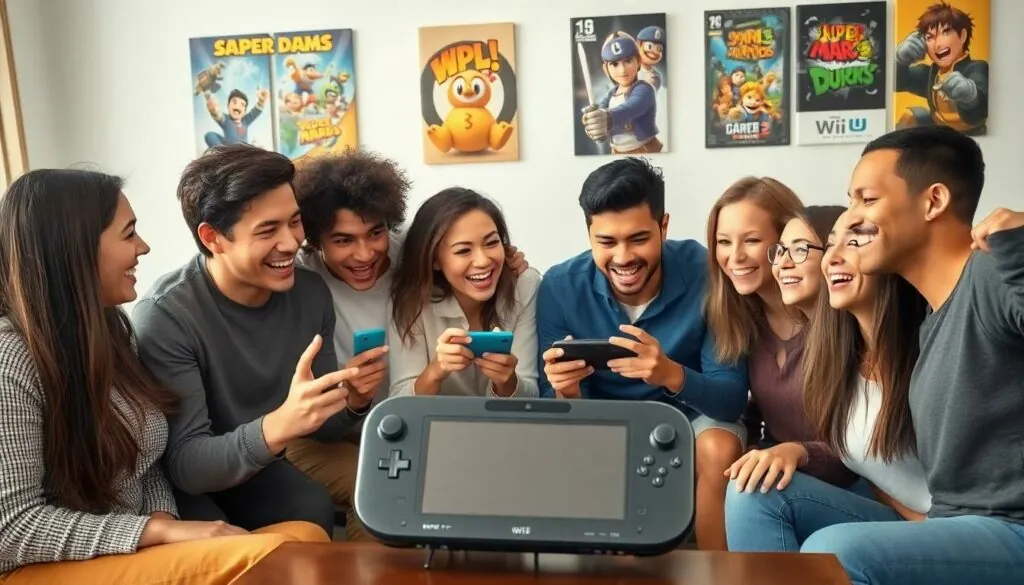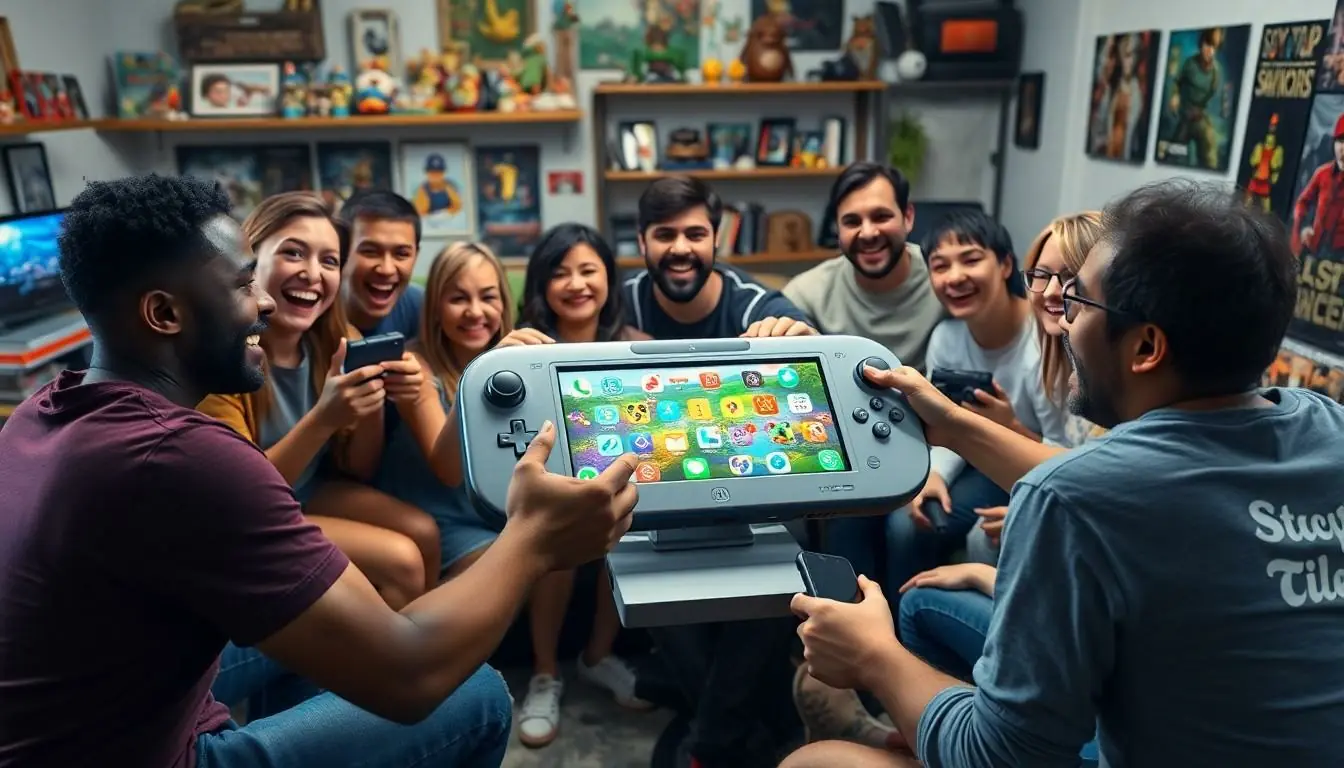In the world of gaming, few moments spark as much excitement as the launch of a new console. Enter the Nintendo Wii U, a quirky contender that promised to take gaming to new heights—or at least to a living room couch near you. With its unique GamePad and a library of titles that could charm even the grumpiest of gamers, it aimed to redefine how players connect with their favorite franchises.
Table of Contents
ToggleOverview of Nintendo Wii U
Nintendo released the Wii U on November 18, 2012, in North America, introducing a new way to engage with gaming. This console features a unique GamePad, enhancing gameplay by integrating a touchscreen interface. Players can utilize the GamePad for off-screen play, enabling seamless transitions between television and handheld modes.
Significant titles like “Super Mario U” and “Nintendo Land” showcased the platform’s innovative capabilities. This system offers backward compatibility with Wii titles, allowing fans to revisit classic games while encouraging new experiences. The Wii U supports online multiplayer and features Miiverse, a social platform for gamers to connect and share experiences.
Hardware specifications include a custom-built IBM PowerPC multi-core processor and 2GB of RAM, supporting advanced graphics and processing capabilities. The console’s launch lineup also included various third-party titles, enhancing its appeal to a broader audience. Nintendo aims for the Wii U to stand out in a competitive market through unique gameplay offerings and innovative technology.
The introduction of features like NFC for amiibo support provides additional layers of interaction. Developers have praised the console’s versatility and potential, indicating a promising future for the Wii U despite initial challenges in sales and market reception. Engaging content continues to be a focus for the platform, ensuring an evolving gaming ecosystem.
History Leading to Release Date
The development of the Nintendo Wii U reflects a strategic evolution in gaming.
Development Timeline
Nintendo initiated the development of the Wii U shortly after the success of the Wii. Research on innovative features, including the touchscreen GamePad, began around 2010. As early as 2011, developers tested concepts to utilize the dual-screen functionality. The console aimed to blend traditional gaming with new interactive experiences, leading to significant advancements in technology. By mid-2012, Nintendo finalized the hardware, emphasizing backward compatibility and online features. Anticipation built as gamers awaited updates on new titles and functionalities.
Announcement and Reveal
Nintendo announced the Wii U at E3 2011, sparking considerable interest among fans and developers. The reveal showcased the console’s GamePad, highlighting its unique capabilities. Throughout 2012, the company continued to unveil major titles, such as “Super Mario U” and “Nintendo Land.” These strategic reveals emphasized engaging gameplay and the console’s innovative potential. On November 18, 2012, the Wii U launched in North America, marking a significant milestone in Nintendo’s history with a focus on player interaction.
Nintendo Wii U Release Date
The Nintendo Wii U launched on November 18, 2012, marking a significant moment in gaming history.
North America
In North America, the excitement peaked with the console’s release. Gamers eagerly anticipated the innovative GamePad, which promised an enhanced gaming experience. Major titles such as “Super Mario U” and “Nintendo Land” launched alongside the console, showcasing its unique capabilities. Initial sales reports indicated a mix of enthusiasm and challenges as consumers adjusted to the new technology. Nintendo aimed to capture both newcomers to gaming and dedicated fans with its diverse game library and online features. The combination of backward compatibility with Wii titles and vibrant online multiplayer experiences solidified the Wii U’s initial presence in the North American market.
Europe
Europe saw the Wii U’s release on November 30, 2012, following the North American debut. Gamers in the region welcomed the system with excitement, drawn by its unique touchscreen controller. Popular titles like “ZombiU” and “Nintendo Land” expanded the console’s appeal. Initial responses from European players highlighted the engaging social platform, Miiverse, enhancing the community aspect of gaming. The focus on local multiplayer experiences further bolstered the Wii U’s popularity in Europe, positioning the console as a centerpiece for social gaming. Sales fluctuated as the market adjusted, but the commitment to continued software support showcased Nintendo’s dedication to the region.
Japan
Japan experienced the Wii U launch on December 8, 2012, shortly after the North American and European releases. The console’s arrival generated substantial buzz among Japanese gamers eager for innovation. Unique titles such as “New Super Mario Bros. U” and “Monster Hunter 3 Ultimate” captured attention, utilizing the GamePad’s features effectively. Japanese sales highlighted strong interest initially, although competition from other platforms posed challenges. Nintendo’s strategy included extensive software support that aimed to cater to local gaming preferences. Engaging features and backward compatibility contributed to the console’s overall appeal, making it a noteworthy addition to Japan’s gaming landscape.
Significance of Release Date
The release date of the Nintendo Wii U marked a pivotal moment in gaming history. Launched on November 18, 2012, in North America, it introduced significant new features that transformed player engagement. This innovation included the GamePad, which enhanced gameplay through dual-screen functionality and off-screen options.
Timed before the holiday season, the launch aimed to maximize sales and market impact. The introduction of flagship titles such as “Super Mario U” and “Nintendo Land” showcased the console’s unique capabilities, further elevating its significance in the competitive gaming landscape. Enthusiasm built with the announcement at E3 2011, highlighting Nintendo’s vision for the Wii U as a bridge between traditional gaming and new experiences.
Regional releases followed swiftly, with Europe receiving the console on November 30, 2012, and Japan on December 8, 2012. Global enthusiasm varied, influencing initial sales figures significantly. In North America, players embraced the GamePad’s capabilities amidst mixed sales reports. European gamers appreciated the unique touchscreen controller, while Japan generated a notable buzz with popular titles like “New Super Mario Bros. U.”
Support for backward compatibility with existing Wii titles fostered nostalgia among long-time Nintendo fans and created opportunities for new gamers. Continuous software support and engaging content emphasized Nintendo’s commitment to the Wii U’s success. Launch timing and market strategy proved vital elements, as industry response shaped the console’s future in an increasingly competitive environment.
Conclusion
The Nintendo Wii U’s release on November 18, 2012, marked a pivotal moment in gaming history. Its innovative GamePad and unique features set it apart from previous consoles, offering players a fresh way to engage with their favorite titles. While initial sales varied across regions, the excitement and potential of the Wii U laid the groundwork for future Nintendo endeavors.
As gamers embraced the console’s capabilities, it became clear that the Wii U was more than just a new device; it was a bold step into the future of interactive entertainment. The legacy of the Wii U continues to influence gaming, reminding players of the importance of innovation and creativity in the industry.







